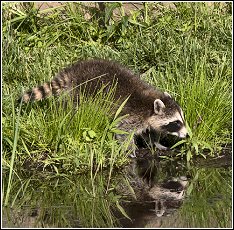Survival And Movements Of
Translocated Chicago Raccoons
Synopsis
As published in the Journal Of Wildlife Management in 1999, this study utilized three different treatment groups of raccoons, each representing a different relocation or translocation scenario. The first group consisted of raccoons captured in urban and suburban Chicago by animal control officers in response to residential complaints, the second group of raccoons consisted of rural animals captured in a forest preserve environment that was similar in nature to the preserve where they would be released (but in a different location), and a third study group was made up of "resident" raccoons already living in the forest preserve being utilized by the study. All raccoons were captured and radio collared to monitor mortality rates and dispersal tendencies (how far they traveled after release). The study was done in the fall of each year, as this is the time of year when most nuisance raccoon complaints occur.
Survival rates did not differ much between groups, however, there were differences in the denning environments the raccoons chose, and in the distance traveled by each group after release.
"Resident" raccoons, already used to that particular forest preserve, tended to stay close to the area where they were released and typically chose to den in the wooded environment of the preserve. The denning choices of the two translocated groups of raccoons were more varied, with some once again settling close to human residences, in wooded environments, in agricultural fields or along waterways. The two groups of translocated raccoons tended to journey farther away from the release site with one raccoon eventually being discovered over 35 miles away.
Please read the full study for a better picture regarding the methods used by the researchers, as well as the findings and conclusions they reached.

Additional Studies
For further information on this topic, you may wish to read an additional study conducted on relocated raccoons in Canada.
The study focused on the effects of moving raccoons from an urban environment to a rural setting or town.
1242 SW Pine Island Rd., Suite 310
Cape Coral, Florida 33991-2126
help@totalwildlifecontrol.com














